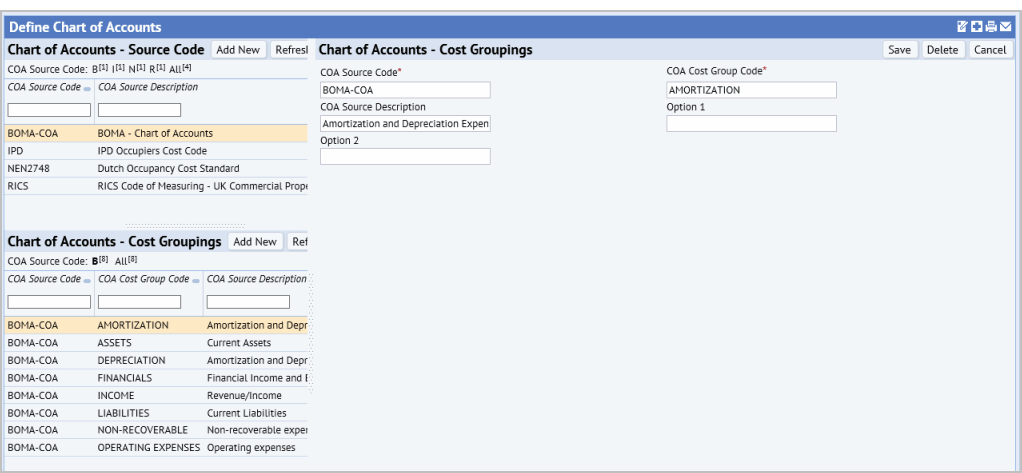The Define Chart of Accounts form appears.

The Chart of Accounts - Source Code form appears.

A chart of accounts (COA) is a financial organizational tool that provides a complete listing of every account in an accounting system. An account is a unique record for each type of asset, liability, equity, revenue and expense.
Regionally, a company may need to comply with a local COA numbering structure. For example, in the United States, the BOMA (Building Owners and Managers Association) has a BOMA – Chart of Accounts that is used by US-based companies to break down account codes into US-centric COA Cost Groupings. If you are a United Kingdom-based organization, you report accounting costs using the COA Source Code: RICS Code of Measuring - UK Commercial Property Market.
The Chart of Accounts includes an account's Source Code - a unique identifier for the chart of accounts - and a description. The Chart of Accounts includes groupings for each type of asset, liability, equity, revenue. and expense.
When defining ARCHIBUS accounts in the Accounts table, you can optionally associate each account with a Chart of Accounts and Grouping, so that the application can summarize your transactions by COA source groupings.
When using the Strategic Financial Analysis application, you can use the Define Chart of Accounts task to map financial Chart of Accounts to ARCHIBUS Cost Categories for integrating finance data.
The Cost Administration and Strategic Financial Analysis applications include features to flexibly map ARCHIBUS costs to your organization's Chart of Accounts using Source Codes and Cost Groupings. The account structure allows for both operating expenses (such as base rents of cost for snow removal), and capital expenses (such as assets costs, depreciation and amortization.) Both categories are used for evaluating cost performance of real estate when justifying investment in real estate and evaluating use.
Operating Expenses are typically used for statistics concerning the Total Cost of Occupancy. The application uses Operating Expense costs to determine facility metrics such as Cost per Area, Cost per Employee, and Cost per Line of Business (LOB) … Business Units / Divisions / Departments.
Operating Expenses plus Capital Expenses (asset costs, income, depreciation and amortizations) are typically used for determining the Total Cost of Ownership. For TCO Reporting, the application uses the Cost Category – Cost Type (cost_cat.cost_type) field values for Cost Grouping. For tracking Total Cost of Ownership, the application tracks and analyzes both OpEx and CAPEX costs when looking to determine Facility Metrics such as, Cost per Area by Building, Cost per Employee by Building, and Cost per Line of Business (LOB) by Building … Business Units / Divisions / Departments.
Total Cost of Ownership = OpEx + CAPEX
For Total Cost of Ownership reporting, you should:
To define a source code for a chart of accounts:
The Define Chart of Accounts form appears.

The Chart of Accounts - Source Code form appears.

To define a cost grouping for a chart of accounts:
The cost groupings defined for that char of account appear. in the Chart of Accounts - Cost Groupings pane.
The Cost of Accounts - Cost Grouping form appears. The COA Source Code is filled in with the source code you selected.

| Copyright © 1984-2016, ARCHIBUS, Inc. All rights reserved. |